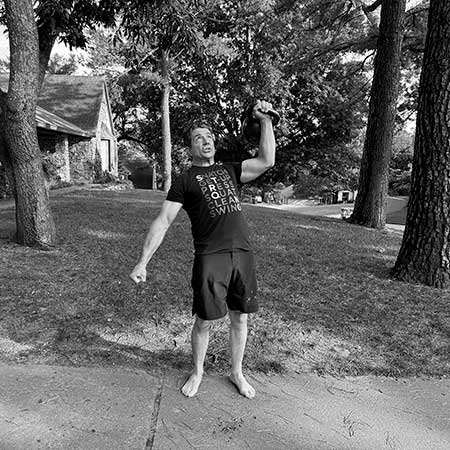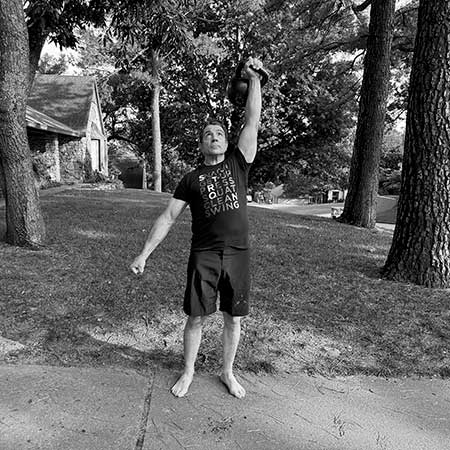Introduction
I’ve been a fan of Brett Jones’s “Iron Cardio” program since he first told me about it. I think it’s an excellent regimen for maintaining and improving general fitness, which at 54 years old, is my primary goal. Naturally, I do have other more specific performance goals, one of which is to eventually (finally) press the 48kg “Beast” kettlebell. My previous best a few years ago was the 44kg, but that is no longer within reach. In fact, a very difficult single with the 40kg was probably within reach when I began this program a couple of months ago, but only on an exceptionally good day. I could, however, press the 36kg for 2-3 reps so that became the 1RM I used in my calculations.
I have done a lot of Iron Cardio over the last year in various iterations: standard issue, traveling 2s, and ladders. I enjoy Iron Cardio a lot because it’s flexible and the variety of lifts keeps your mind focused and allows for lots of technical practice.
Since pressing the 48kg is my long-term goal, I thought maybe I could work on my press within the Iron Cardio format. I have done a lot of press specific programs over the years that were very helpful at improving my press, but at this point I wanted to do something a little more general fitness oriented while still working on my press. So, I chatted with Brett about the idea and after his advice, I opted for an Iron Cardio 1-2-3 press ladder program, with a few modifications.
Being a huge fan of Plan StrongTM, I wanted to try and combine Iron Cardio with some Plan Strong principles with the goal of improving my press past the standard Iron Cardio rep ladder. How would I accomplish this? If you’re familiar with Plan Strong, you know the programming is quite meticulous. I didn’t want to go through all the steps, but I needed to adhere to enough of the principles in order to be confident that progress would be made.

Which Principles to Use?
The most important Plan Strong principle, in my opinion, is the Delta-20 principle which stipulates that the volume must change ±20% from session to session, week to week, month to month.
The second most important Plan Strong principle is the weekly volume/intensity pattern which says session one is lowest volume and lowest intensity, session two is medium volume and highest intensity, and session three is highest volume and medium intensity.
Both principles were easy to apply to this program. For Delta-20, I simply decided on a total volume for the month, and then broke that into four different weekly volumes that were separated by 20% or more, and then broke those weeks into three sessions per week with the session totals having a 20% or more difference between each other as well. The calculations for this step took a few minutes, but the math isn’t hard.
The weekly volume/intensity pattern was even easier to apply. Using the 36kg as my 1RM and knowing that Plan Strong puts the bulk of work in the 75%-80% of 1RM range, I made the 28kg (77% 1RM) the main kettlebell for the program. I took my lowest session volume for the week and put that in session one. To up the intensity on session two, I simply assigned the 32kg (88% 1RM) presses there as well as a higher volume of reps with the 28kg. And for session three, I did the remaining reps for the week with the 28kg.

Session Details
I applied these principles to the press in month one as follows:
Number of Lifts (NL) for Month One

**This volume is more than would normally be done in a typical Plan Strong session, and I changed the ladder from 1, 2, 3 to 2, 3, 5 to get through the session.
Month one went well but I wanted to experiment with a lower volume for the heavier load (32kg). So, for month two, I lowered the 32kg press volume from 11% to 3%.
Number of Lifts (NL) for Month Two

You will notice that the totals for months one and two change by at least 20%, as do each weekly total and each session total thereby keeping the program in adherence to Delta-20. You’ll also notice that the volume increases as sessions progress from one to three, but the heavier presses are done only in session two, thereby ensuring the intensity was highest in that session while the volume continued to increase throughout the week.
I followed Iron Cardio’s base format of clean/press/front squat, only laddering the press. A session would go as follows:
- clean/press/front squat
- clean/press x 2/front squat
- clean/press x 3/front squat
I would repeat that sequence until the press volume was complete. Every sequence totaled six presses. Sometimes the volume for the session was divisible by six, other times not. Month one, week one, session one totaled twelve presses so two times through the sequence and the math is complete. But for session three of that week the total is 44. So, I did the sequence seven times (42 reps) plus one more sequence with two presses totaling 44 for the session.

Results
I was curious what progress I would make in such a short time with rep ranges very different from a typical Plan Strong program. When I started two months earlier the 36kg was my 2-3 rep max. At the end of the two months, I comfortably pressed the 36kg for six reps on each side, and probably could have grunted out another. Then I rested for five minutes and pressed the 40kg once on each side. Remember this was all done by pressing the 28kg for the vast majority of the total volume (89% of total volume in month one and 97% in month two) and drastically reducing the amount of 32kg presses the second month.
There is a bit of math needed to write up this kind of program, but it’s not hard and really delivers great strength bias results within the Iron Cardio format, which builds and maintains general fitness incredibly well. I don’t want to bore you with too many program specifics but for those of you who are curious about more details feel free to reach out to me: jvs_hardstyle@protonmail.com.
Stay strong, my friends!






Hi John,
very interesting article, thank you. I have two questions:
1 — Top-down volume calculation
You write that you simply decided on a total volume for the month, then broke that down into four weekly volumes, which you then distributed over the three weekly training days.
To me, that’s the least obvious part of your process. It’s very difficult to know how much training you can tolerate as a monthly aggregate unless you previosly have calculated your training volume bottom-up. This means knowing how much day-to-day volume you can effectvely recover from in order to make a 3-day weekly schedule possible.
So my question is: what’s the reason you’re able to go top-down?
1. You have performed the bottom-up volume calculation previously (say, from doing other programs), and hence know your personal ballpark monthly training volume.
2. You go by a “general prescription” monthly NoL that you applied to this program.
3 — The Plan Strong intensity triad
You write that Plan Strong prescribes three categories of intensity: Low, Medium, and High. For example, the 1st training day of the week uses low volume and low intensity.
However, your program uses only two categories of weight: 28kg and 32kg. That makes it Medium / High intensity, and on the 1st training day you’re using the same low intensity as on the last training day (28kg), making the program vary only on volume.
Am I interpreting this correctly?
Thank you!
This is a Great article John!!!
Great stuff, John.
Did you do any other training (eg Simple and Sinister) during the week?
Great approach, John.
Love it!
Hi John, thanks for this great article. I was wondering if the volume is per arm or split between the arms? And did you do singles or doubles?
Food for thought… thank you John!
Strong work coach!